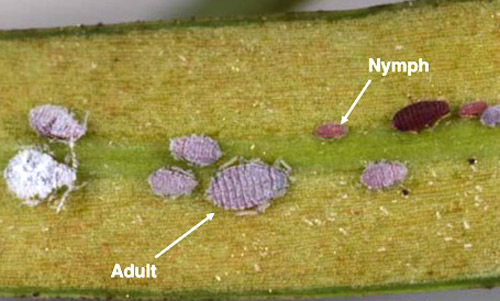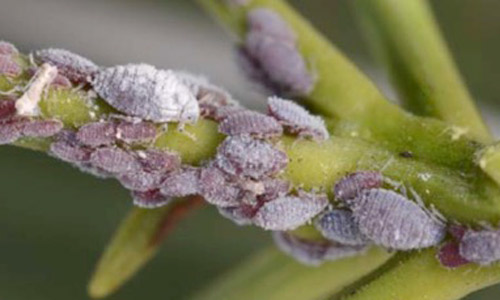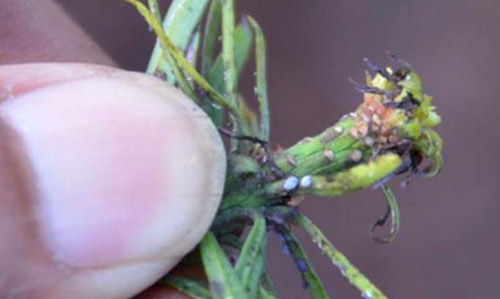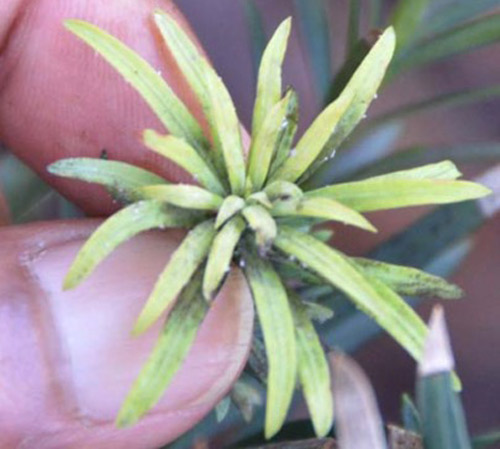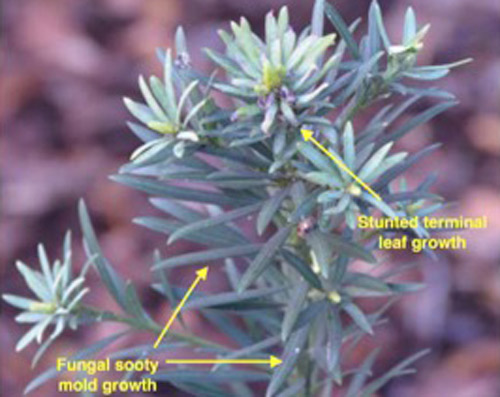common name: podocarpus aphid (suggested common name)
scientific name: Neophyllaphis podocarpi Takahashi (Insecta: Hemiptera: Aphididae)
Introduction - Distribution - Description and Biology - Hosts - Damage - Symptoms of Damage - Management - Selected References
Introduction (Back to Top)
The podocarpus aphid, Neophyllaphis podocarpi Takahashi, is a pest of Podocarpus species in Florida, namely the nonnative ornamental shrub Podocarpus macrophyllus (common names include bigleaf podocarpus, kusamaki, podo, Japanese yew, and southern yew) (Stamps no date). The podocarpus aphid is recognizable by its blueish purple color (Figure 1). First found in Florida in Miami in 1968, this invasive aphid can now be found anywhere in Florida where the genus Podocarpus is grown (Brown and Mannion 2014).
Distribution (Back to Top)
The podocarpus aphid is found in its native range of China, Japan, Malaysia, and Taiwan, the Riao Islands of Indonesia, and Australia. The podocarpus aphid was reported previously as a native aphid of New Zealand, but recent taxonomic work determined that it was mistakenly identified, and the aphid species present in New Zealand is actually Neophyllaphis totarae (Cottier) (Teulon et al. 2013). In the United States, the podocarpus aphid has been found in California, Florida, Hawaii, Louisiana, Mississippi, and Texas (Russell 1982, Hidalgo et al. 2015).
Description (Back to Top)
The podocarpus aphid is easily distinguishable from other aphids by its bluish-purple color (Hidalgo et al. 2015) (Figure 1). The body of the adult aphid is 1.3 mm in length and flattened dorsoventrally (Takahashi 1920, Foottit et al. 2012). The antennae are six segmented and shorter than the length of the body (Russell 1982). The female aphids can be winged or wingless. Wingless females are oval and have a white wax dusting while winged females are similar in appearance, with a slight difference in antennal and leg structure (Hidalgo et al. 2015). The winged females will often have small scent glands, called pseudosensoria, present on their hind tibiae (the first segment of their hind legs) (Russell 1982). Podocarpus aphids tend to aggregate on the stems and leaves of their host plant (Miller and Halbert 2014) (Figure 2). Another aphid in the same genus, Neophyllaphis varicolor, is often seen on podocarpus plants in Florida and appears similar to the podocarpus aphid, except the nymphs of these aphids can be yellow, orange, red, or purple in color (Miller and Halbert 2014). The adults of the similar aphid species also differ in being a slightly darker reddish-purple color. Additionally, they are not as round as the podocarpus aphid, are more mobile, and do not aggregate as densely (Miller and Halbert 2014).
Figure 1. Podocarpus aphid, Neophyllaphis podocarpi Takahashi, adults and nymphs. Photograph by Lyle J. Buss, University of Florida.
Figure 2. Podocarpus aphid, Neophyllaphis podocarpi Takahashi, adults and nymphs. Photograph by Lyle J. Buss, University of Florida.
Life History (Back to Top)
Podocarpus aphids will find and feed on only one host plant during its lifecycle. Podocarpus aphids live exclusively on coniferous plants, with a preference for Podocarpus species (Russell 1982). Sexually mature podocarpus aphids appear in the spring, summer, and fall seasons (Russell 1982). Podocarpus aphids have been observed feeding on the youngest leaves, twigs and fruit stems of their host plant (Hidalgo et al. 2015). The aphids can be found in high densities on fruit stems, and can be found there in aggregations from three to fifty individuals (Hidalgo et al. 2015). There have been reports of aphids in the genus Neophyllaphis being attacked by entomopathogenic fungi and coccinellid beetles. No parasitoids have been reported attacking aphids of Neophyllaphis (Russell 1982).
Hosts (Back to Top)
The podocarpus aphid has been documented feeding on conifers in the plant families Araucariaceae, Cupressaceae, and Podocarpaceae, with the podocarpus aphid found on all podocarpus species grown in Florida. These species include Podocarpus macrophyllus (yew plum pine, and Buddhist pine), Podocarpus chinensis (plum pine), Podocarpus henckelii (Henkel's yellowwood), Podocarpus nageia (broadleaf podocarpus), and Podocarpus neriifolius (brown pine) (Hidalgo et al. 2015).
Survey and Detection (Back to Top)
Large populations of podocarpus aphids can cause stunting and curling of new growth on host Podocarpus plants (Figure 3, Figure 4).
Figure 3. Terminal leaf damage on podocarpus caused by podocarpus aphids, Neophyllaphis podocarpi Takahashi. Photograph by Stephen H. Brown, University of Florida.
Figure 4. Stunted terminal leaf growth of podocarpus caused by podocarpus aphids, Neophyllaphis podocarpi Takahashi. Photograph by Stephen H. Brown, University of Florida.
Large aggregations of podocarpus aphids can lead to honeydew build-up and sooty mold formation on the plant (Figure 5), which can inhibit photosynthesis (Hidalgo et al. 2015).
Figure 5. Stunted new leaf growth from feeding damage and sooty mold growth on excreted honeydew on podocarpus caused by podocarpus aphids, Neophyllaphis podocarpi Takahashi. Photograph by Stephen H. Brown, University of Florida.
Management (Back to Top)
Control of the podocarpus aphid is usually not necessary unless numbers become high enough to cause considerable plant damage. Aphid populations are often reduced by natural enemies such as predatory beetles. If damage to plants becomes severe, the following control measures may be used: insecticidal oils and soaps, contact insecticides, and systemic insecticides (based on label recommendations for the location of the plant). Oils and soaps are most effective on low infestations of podocarpus aphid. They are most effective when applied directly to the host plant three times, with seven to ten days between applications. It is important to not apply oils and soaps when it is hot and sunny outside or the leaves may be damaged (a condition referred to as burn). Be sure to follow the label instructions on all insecticides.
Selected References (Back to Top)
- Brown SH, Mannion C. 2014. Aphids (Neophyllaphis podocarpi and N. varicolor) on Podocarpus macrophyllus. University of Florida Institute for Food and Agriculture Sciences, Lee County Extension. (30 August 2017)
- Foottit RG, Maw HEL, Pike KS, Messing RH. 2012. Aphids (Hemiptera: Aphididae and Adelgidae) of Hawai’i: Annotated list and key to species of an adventive fauna. Pacific Science 66: 1-31.
- Hidalgo NP, Hernández-Castellano C, Garcia Figueres F. 2015. First record of Neophyllaphis podocarpi Takahashi (Hemiptera: Aphididae) in the Iberian Peninsula. European Plant Protection Bulletin 45: 103-105.
- Miller GL, Halbert SE. 2014. A new species of Neophyllaphis (Hemiptera: Aphididae: Neophyllaphidinae) with keys to species on Podocarpus (Pinales: Podocarpaceae). Proceedings of the Entomological Society of Washington 116: 69-79.
- Russell LM. 1982. The genus Neophyllaphis and its species (Hemiptera: Homoptera: Aphididae). The Florida Entomologist 65: 538-573.
- Stamps RH. No date. Foliage plants for use as florists’ “greens”. University of Florida Central Florida Research and Education Center, CFREC Cut Foliage Research Note RH-99-A. pp 8-10.
- Takahashi R. 1920. A new genus and species of aphid from Japan (Hem.). Canadian Entomologist 52: 19-20.
- Teulon DAJ, Stufkens MAW, Drayton GM, Maw HEL, Scott IAW, Bulman SR, Carver M, Von Dohlen CD, Eastop VF, Foottit RG. 2013. Native aphids of New Zealand—diversity and host associations. Zootaxa 3647: 501-517. DOI: https://doi.org/10.11646/zootaxa.3647.4.1.
